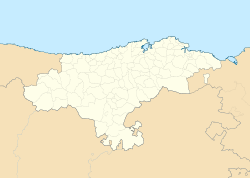Villacarriedo
In this article, we are going to delve into the fascinating world of Villacarriedo. From its impact on society to its relevance in history, Villacarriedo has played a fundamental role in various aspects of daily life. Over the years, Villacarriedo has captured the attention of many people, generating debate and reflection on its influence in different spheres. Through detailed analysis, we will explore the meaning of Villacarriedo and how it has shaped our way of understanding and approaching certain aspects of life. We hope that this article leads you to reflect and provides you with a deeper insight into Villacarriedo and its importance in today's society.
Villacarriedo | |
|---|---|
 | |
| Coordinates: 43°13′46″N 3°48′33″W / 43.22944°N 3.80917°W | |
| Country | |
| Autonomous community | Cantabria |
| Province | Cantabria |
| Seat | Villacarriedo |
| Government | |
| • Alcalde | Ángel Sainz Ruiz (PRC) |
| Area | |
• Total | 50.74 km2 (19.59 sq mi) |
| Elevation | 211 m (692 ft) |
| Population (2018)[1] | |
• Total | 1,604 |
| • Density | 32/km2 (82/sq mi) |
| Time zone | UTC+1 (CET) |
| • Summer (DST) | UTC+2 (CEST) |
| Postal code | 39640 |
| Website | Ayunt. de Villacarriedo |
Villacarriedo is a municipality in the Spanish "comunidad autónoma" of Cantabria.
Sub-districts and demography
In 2009 the municipality contained 1,765 registered inhabitants divided between the various villages and hamlets as follows:
- Abionzo (174 people)
- Aloños (159 people)
- Bárcena de Carriedo (185 people)
- Pedroso (71 people)
- Santibáñez (254 people)
- Soto (29 people)
- Tezanos (385 people)
- Villacarriedo (capital) (508 people)
Location
Villacarriedo, the administrative centre and the most populous village in the municipality, is positioned 211 meters above sea level and 36 km (22 miles) to the south of Santander, the Cantabrian capital.
Economy
36.9% of the working population are recorded as working in the primary (agricultural) sector. 15.1% work in construction and 10.8% in industry while a further 37.2% work in the tertiary (service) sector.
- ^ Municipal Register of Spain 2018. National Statistics Institute.


